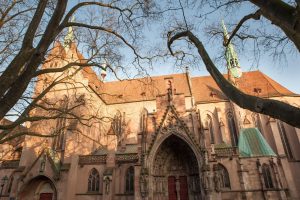 The church of Saint-Pierre-le-Jeune © Archives/Ville de Strasbourg
The church of Saint-Pierre-le-Jeune © Archives/Ville de Strasbourg
As early as 1524 the parish approved the Reformed ideas. Wolfgang Capiton was its first pastor. In 1682 the building was split between Lutheran and Catholic worship, the former using the choir; a wall then separated the nave from the choir.
In the mid 19th century, on the initiative of pastor Friedrich Horning, The New Church of Saint Peter became the beacon of the Lutheran Revival that deeply marked the history of the parish. When the Catholic parish moved to a new building, the reunited church, as well as the cloister, were totally restored under the supervision of architect Carl Schäfer.